|
SITE
INDEX
QUICKENING
NEWS
PREPARATIONS
1.
Food
2.
Manna
Meals
3.
Water
4.
Sanitation
5.
Medical,
health
6.
Kerosene heaters and cookers
7.
Lighting
8. Wood
cooking and heating
9. Communi-cations
10. Essential
Tools
11. Home
built items
12.
Electrical; generators
and power
13. War
preparedness
14.
Gardening
SITE
INDEX
Miles Stair's SURVIVAL
SHOP
HOME
RADIATION
INDEX & JET STREAM
PROPHECY
COMMENTARY
BY MILES
BOOKLETS
BY MILES
GUEST
SUBMISSIONS
PHOTO
INDEX
LINKS
SITE
INDEX
Miles Stair's
SURVIVAL
SHOP
|
|
Woodworking Tools
For Cabin Building, etc.
See also:
Tools -
Restoration and Rebuilding
Tools For Cabin Building
WOOD
CUTTING AND SPLITTING TOOLS
How to make sheathes to keep tools sharp.
The photos below show
tools that can be used to make about anything from wood, right
up to building cabins and homes. Many of these tools
were purchased on eBay in relatively good condition, then
refinished. To keep the tools in top shape, sharp
and ready to use, I made sheaths for many of them using old
Levi pants material. The tools are old and rebuilt so
they can last another century - the ultimate recycling.
|
 |
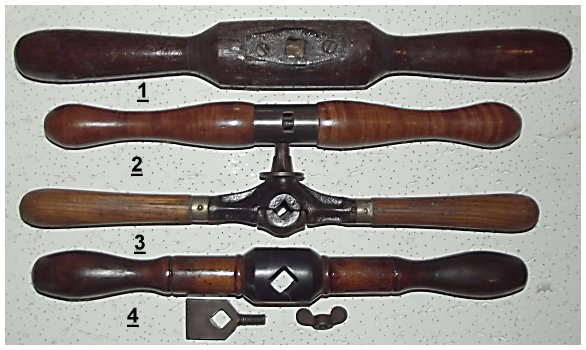 |
|
Short, small
adze used for notching logs for cabin building, in corners
and ends where a large adze will not fit. |
For
post-and-beam construction, augers are mandatory to make
the holes necessary for pegs. The selection shown above is
typical of those available on eBay. #3 is very
versatile for smaller auger bits while #4 is the strongest
type available. |
`
|
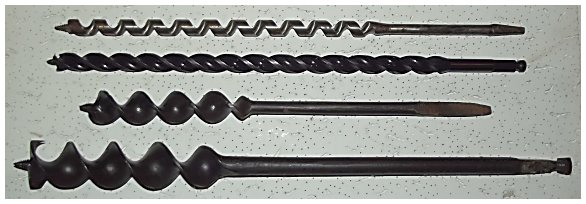 |
 |
|
Auger bits,
the two small ones at top for using 1/2" rebar to secure
logs together, the larger two at the bottom are for
wooden dowels. Long dowels can be purchased or
shaped from hardwood using a spokeshave (below). |
This ratchet
auger handle is for working in tight confines like corners
and window and door frames. The left handle unscrews
and fits on top. The adjustable chuck will hold about any
auger bit. This is a serious auger handle and very heavy. |
`
|
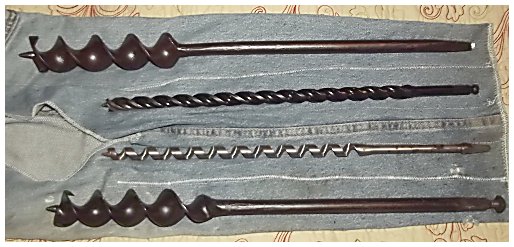 |
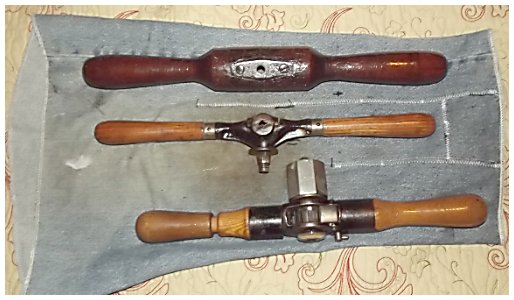 |
| Pant legs from
an old pair of Levi's sewn to make a sheath to keep the
auger bits secure in storage. When stored like this
the cutting edges don't get banged around and stay sharp
and clean. |
Part of a leg
from old Levi pants for storing the auger handles so they
are always clean, rust free and ready to use. |
|
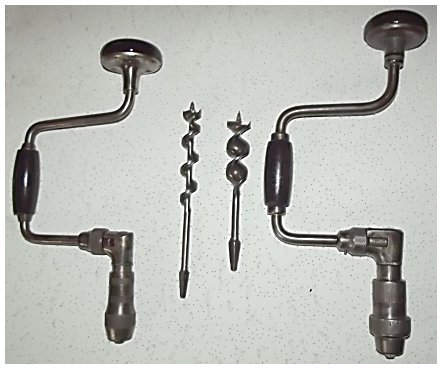 |
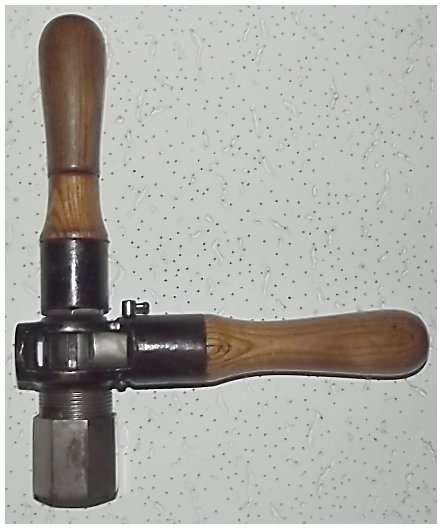 |
| A brace and
bits are used for shallower holes where required.
The brace is also used with dowel making tools, as shown
below, right. |
The ratchet
auger handle shown above but with the handle fastened to
the top. With this arrangement it is possible to
drill straight holes when working in a corner. The upper
part of the top handle rotates to avoid causing blisters. |
`
|
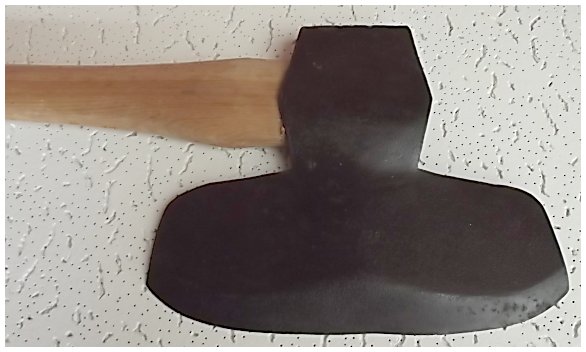 |
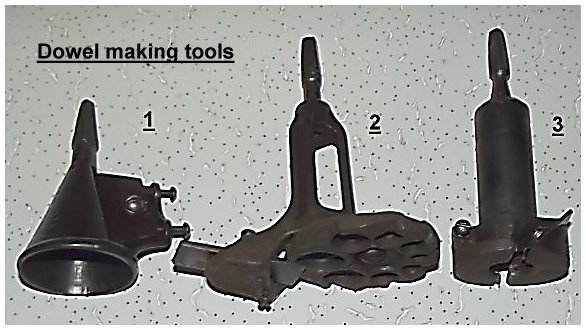 |
| The broadaxe
is used for making flats on logs for foundation
beams and square beams for flooring. This broadaxe
was hand forged over a century ago using high carbon steel
as the cutting edge with softer iron forge-welded to the
top for strength without brittleness. |
These tools
are used with the brace to make dowels. #1 is the
starter, cutting a tapered cone on a piece of wood.
#2 can make to make a dowel to fit the bit used to make
the hole. #3 is used when a square shoulder is
needed at the end of a dowel, such as when making
primitive furniture. |
|
 |
 |
| Draw knives
are used to remove bark and to shape logs, make flats on
logs, etc. The 6" draw knife is very handy to carry
and use when needed, but the handles are too close
together for working large logs and thus can cause real
knuckle bruising. There IS a use for large
fixed-handle draw knives, but for little jobs like tool
handles and small logs, these work fine. |
This shows why
I like folding handle draw knives - a sheath can hold one
right on a tool belt. |
Ancient adjustable-handle
draw knife
|
 |
 |
|
Above is an unusual adjustable-handle draw knife. The
handles don't fold, they rotate to any upward position and
lock in place, and can be removed for compact storage.
This draw knife was made by
Watrous & Co. in Elmira, N.Y.,
based on the
Richard N. Watrous patent of Dec. 15 1857. Watrous
went out of business in 1883 and it is impossible to date
this tool closer than that. And it still works!
|
`
|
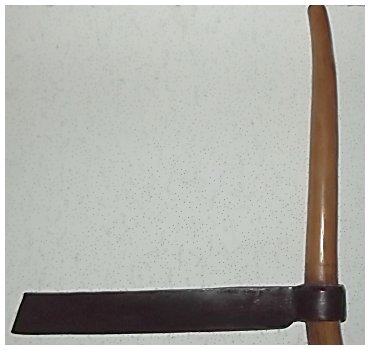 |
 |
| A froe is used
to cut roofing shingles from a "bolt" of 3 foot long,
knot-free cedar. This particular froe was made in
Langlois, OR in the 1930's from a truck leaf spring
and the handle shaped with a spokeshave. |
A leg vise is
a super-duty vise and clamp used for forging and metal
work, and holding tools for sharpening. At least a
century old, after my refinishing it looks and works like
new. |
`
|
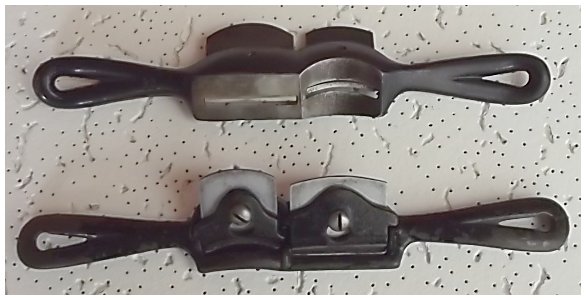 |
 |
| Old
spokeshaves, dual blades, one curved, one flat.
These are used for making spokes for wheels, of course,
and also make tool handles. |
A new inside
curve spokeshave, stainless steel, from Lee Valley Tools.
A handle or spoke is tapered flat at one end, round
tapered in the middle, and then curved up to the size
required to fit into a tool head. This was a
Christmas gift to me from a very special friend. |
`
|
 |
Spokeshaves are lumpy and have
sharp corners. I make belt sheathes for spokeshaves
using thick canvas with inserts cut from the corners of
gallon milk jugs. The inserts are shown at left,
then covered with another piece of thick canvas and sewn
into the shape required to hold the spoke-shave. One side
has a belt loop sewn on, as shown above. The halves are
then sewn together and Zig-Zag stitched around the edges.
The result is a sturdy belt sheath that conforms to the
odd shape of a spokeshave and the plastic inserts prevent
wearing a hole through the canvas over sharp points and
ridges in the tool. |
 |
`
|
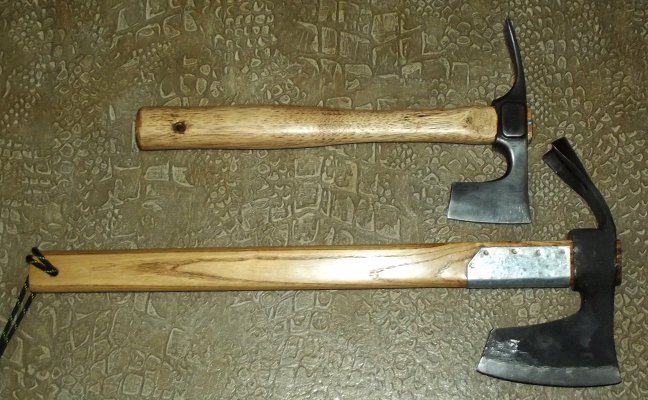 |
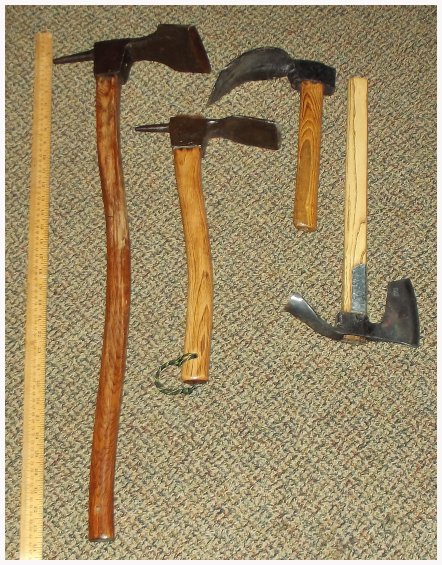 |
| New hatchet/adze tools made by a fellow in
Bulgaria who sells these and many other hand-forged tool
on eBay (World
Thracian Pickers). His handle on the bottom one, the top one
has a hammer handle I fitted and finished. |
A selection of adze tools. Long
handled at left is at least a century old. The
short-handles curved adze (3rd from left) was Italian
military issue for making log walls in trenches. |
`
|
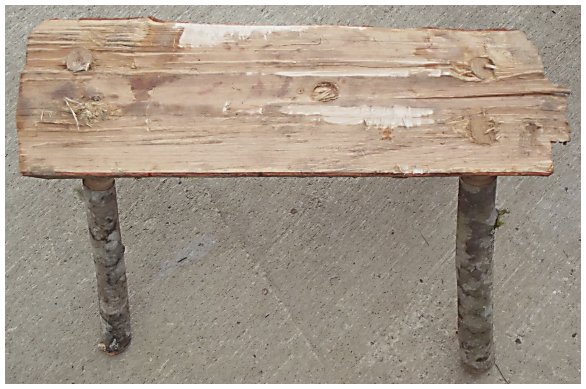 |
 |
| A child's
bench seat made very quickly using a slide off a log.
The bench is drilled for legs. |
The legs are
cut from limbs and a dowel maker on a brace (see above) is
used to make dowels to fit the holes drilled in the seat
at left. |
The Ultimate in Recycled
Tools
|
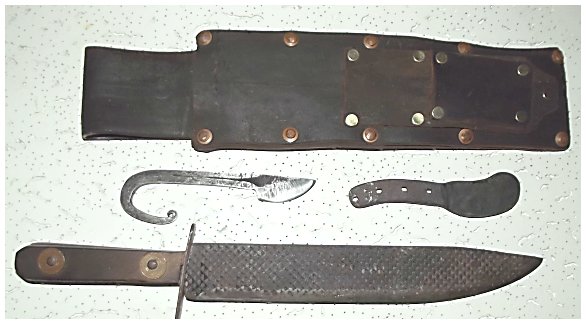 |
 |
| Three knives
hand forged from old files. The handles were made
from dry hardwood found in the forest, shaped and riveted
in place using nails for rivets and copper pennies as
washers. |
The leather
for the sheath was from an old tractor implement power
belt found in an abandoned barn, hand riveted so the
knives all nest as shown above. The cost? Some
nails, rivets, and pennies. |

|
|
|


























